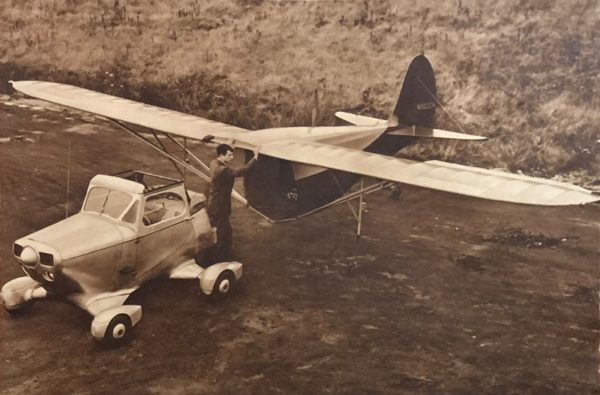
In November 1946 at an airfield in Danbury, Connecticut, Robert Edison Fulton Jr., president of Continental Inc., made the first flight of a car of his own design that converted into an aeroplane. It was aluminium bodied, with independent suspension, aircraft-sized wheels, and a six-cylinder 165 hp engine. The wings and tail were fabric and could easily be attached to the car’s “fuselage”. Our Snapshot shows one of the four prototypes, ready to join the aircraft section of the machine.
It did fly successfully: in December 1950, the American Civil Aeronautics Administration certified one of the prototypes and gave it an 1A11 Aircraft Specification.
Robert Fulton (1909-2004) was a fascinating character. He was an inventor and an adventurer: he travelled around the world on a motorcycle and counted several aviation inventions among his 70 patents. He was also a professional photographer.
His middle name Edison was from Thomas Edison, who was a friend of his father, Robert Fulton Sr., a president of Mack Trucks. His maternal grandfather, Ezra Johnson Travis, ran stagecoach lines across the west after the American Civil War, and his uncle, Elgin Travis, converted the stagecoach routes into bus lines which ultimately became the famous Greyhound Bus Line. As a teenager, he was privileged enough to fly by commercial aircraft from Miami to Havana in 1921, and then to Egypt in 1923 to see the newly opened Tutankhamun’s tomb.
He graduated with a degree in architecture from Harvard in 1931, and at the age of 23 he rode 25,000 miles on a twin-cylinder Douglas motorcycle to study architecture around the world, shooting 40,000 feet of film over an 18-month period. He wrote of his exploits in his book One Man Caravan and made a film of it in 1983.
During World War II, Fulton invented the first ground-based aerial flight trainer, but the military had no interest – so he modified it into the first fixed aerial gunnery trainer, called the “Gunairstructor”. Annoyed by the time it took him to travel to demonstrate it, he had an idea: a car that could be converted into a plane. He called it the Airphibian. He formed Continental Inc. after the war to manufacture aeronautical equipment and his car-plane invention.
The Airphibian was sadly not a commercial success. The costs of airworthiness certification forced Fulton to sell his company, and the project died. During the 1950s Fulton developed a surface-to-air recovery system called the Skyhook, for the Central Intelligence Agency (CIA), the United States Navy and the United States Air Force, to pick up people from the ground with an aircraft. It was used by the USAF until 1996.
Our Snapshot shows how the Airphibian worked. The aircraft section was left behind during road use and the three-bladed propeller was placed on a hook on the side of the fuselage. The car was capable of 45 mph on the road and 125 mph in flight, and conversion took no more than seven minutes.
One of the prototypes survives today in the Steven F. Udvar-Hazy Center, the Smithsonian National Air and Space Museum (NASM)’s annex at Washington Dulles International Airport in the Chantilly area of Fairfax County, Virginia.
Picture courtesy of the Richard Roberts Archive







Leave a Comment